

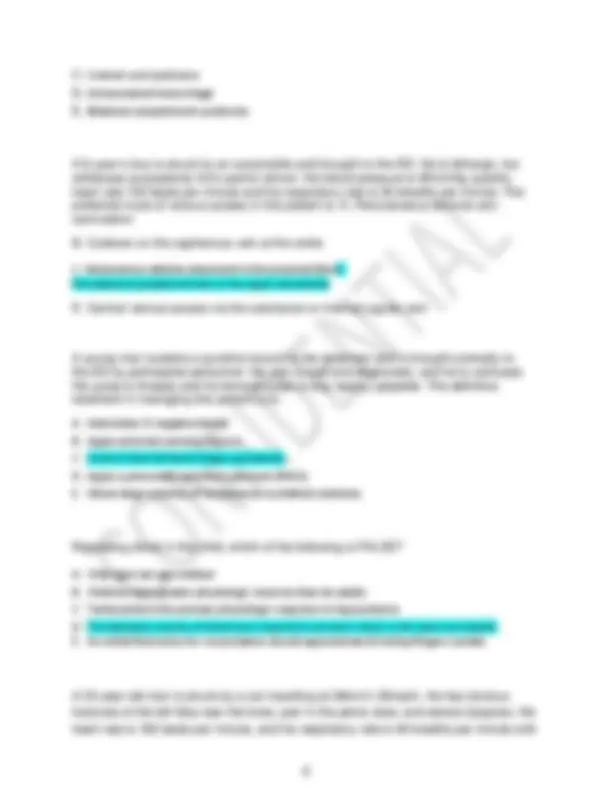

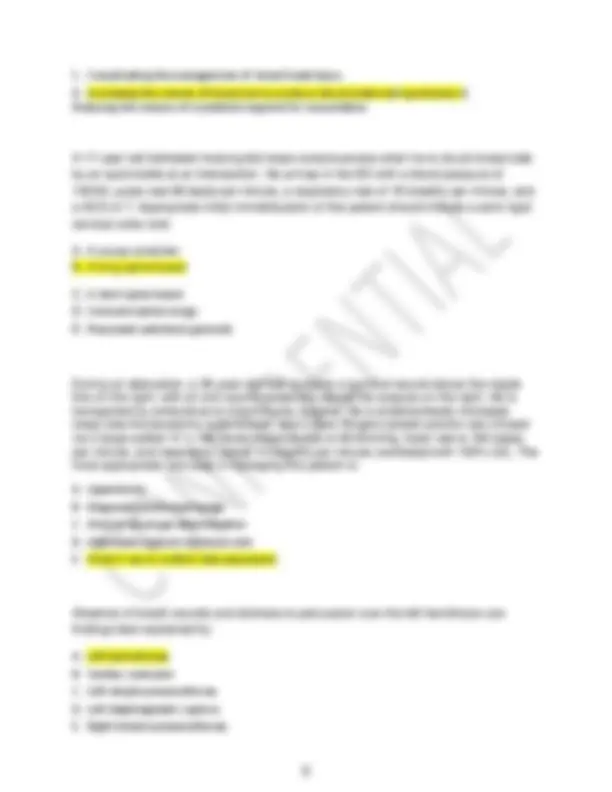
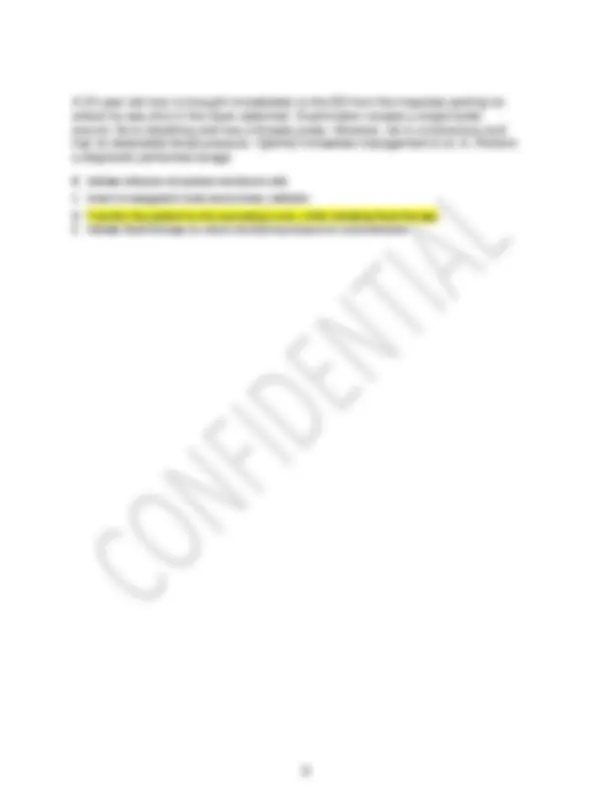
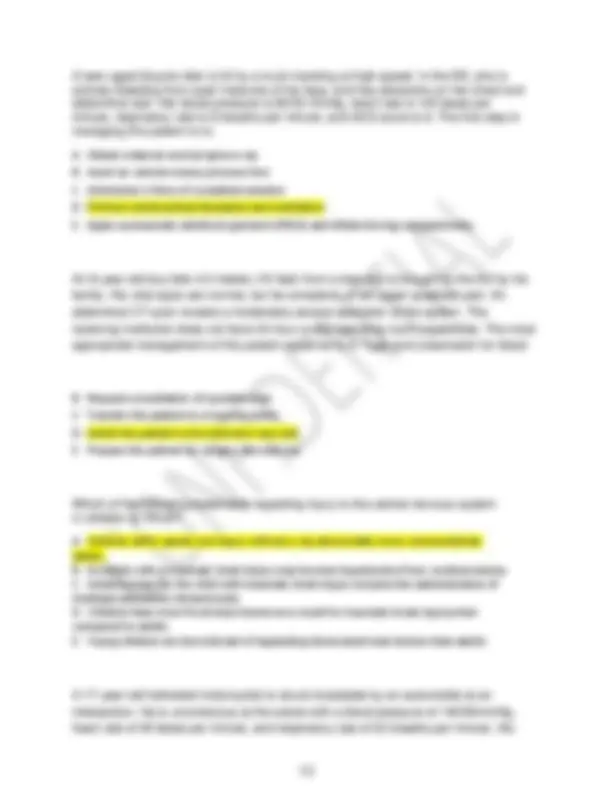
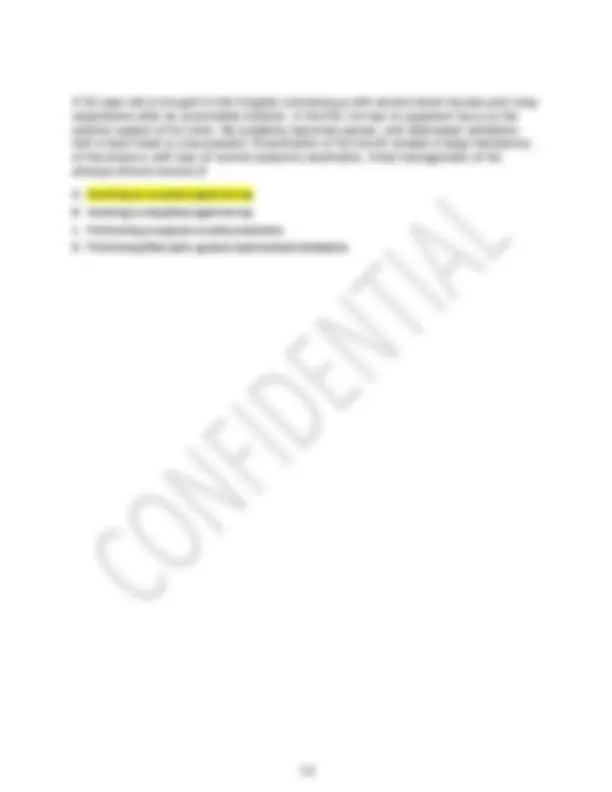
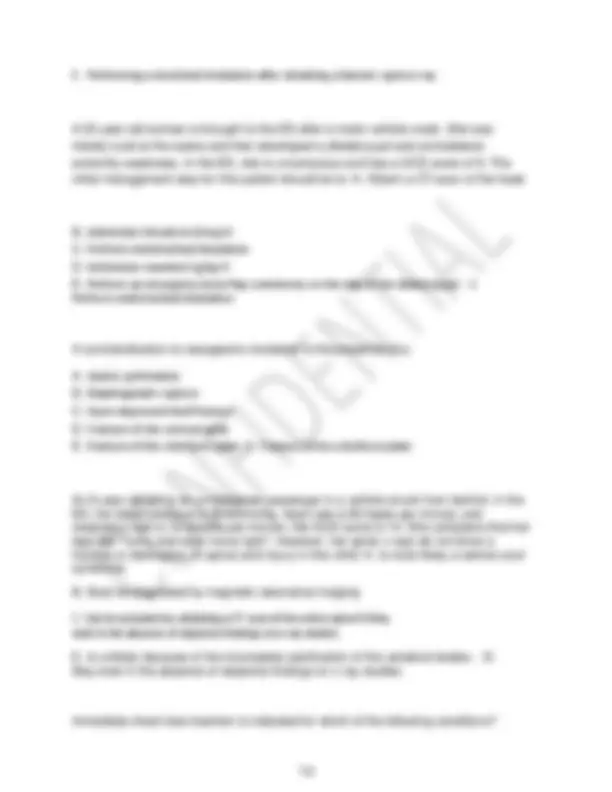

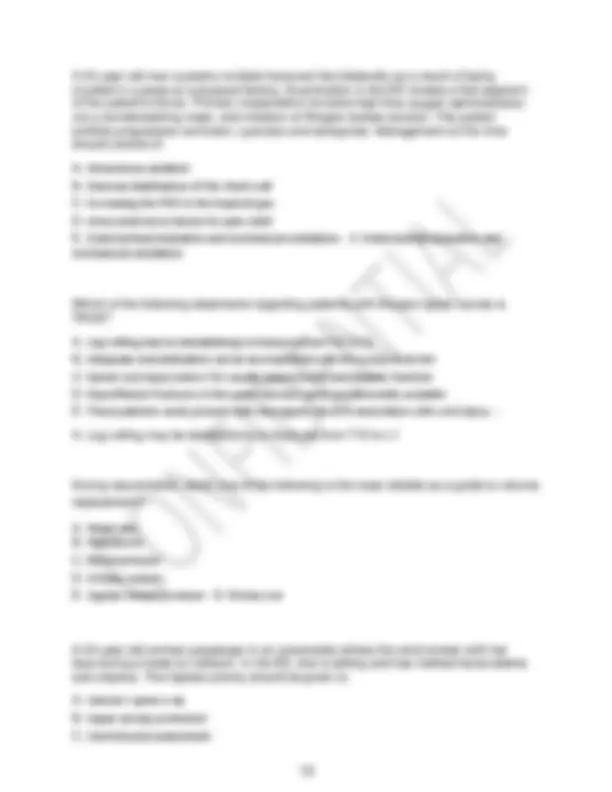
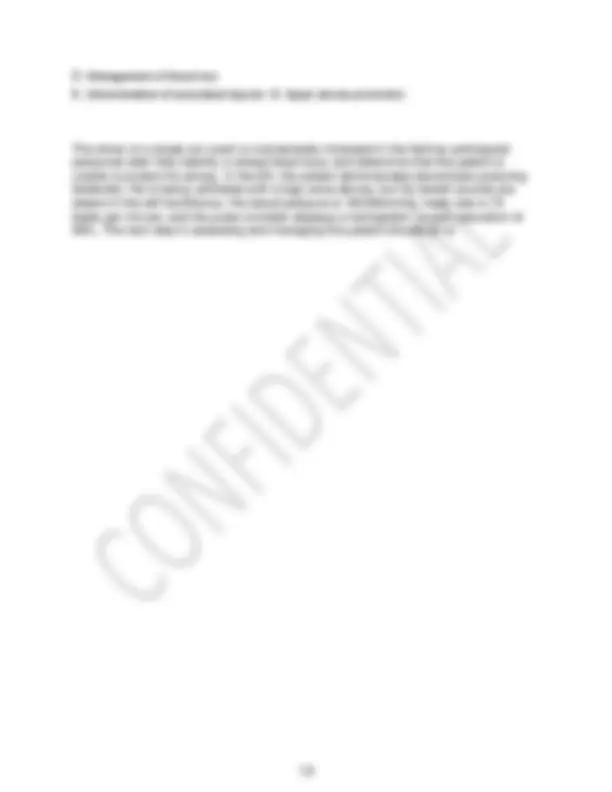
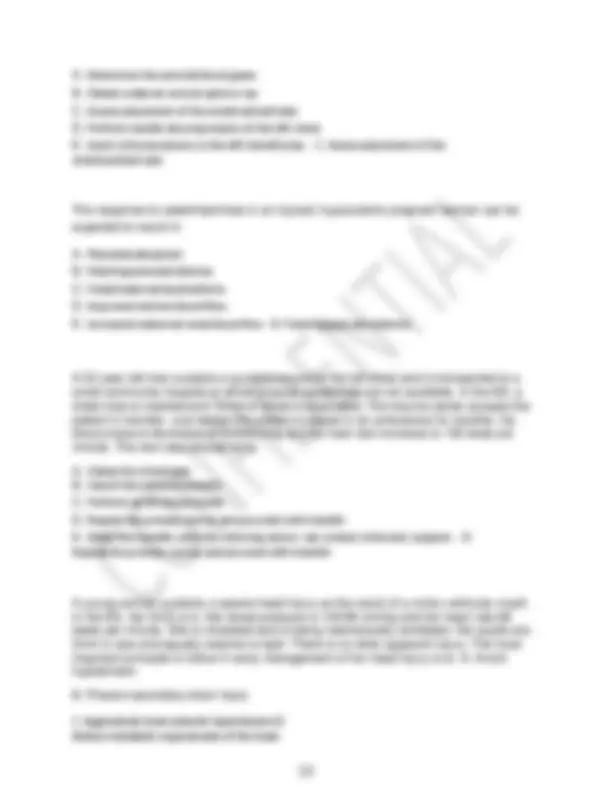

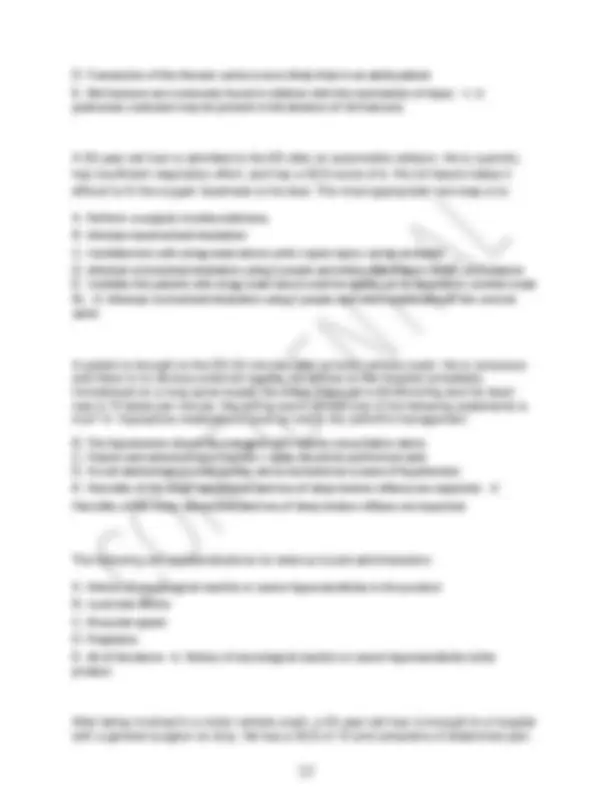

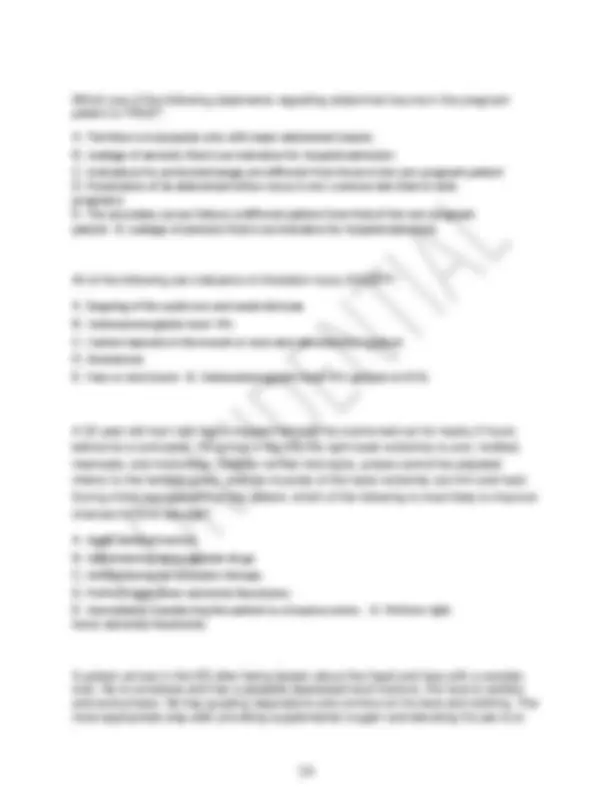

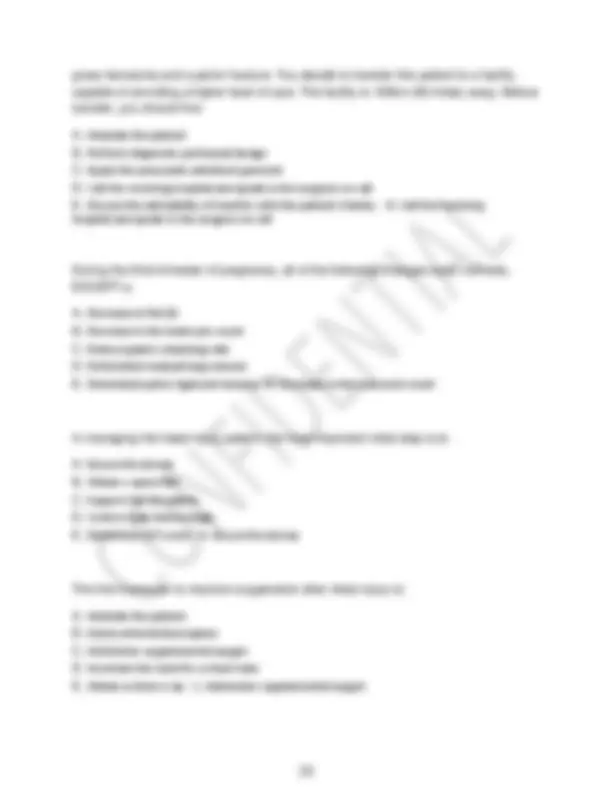

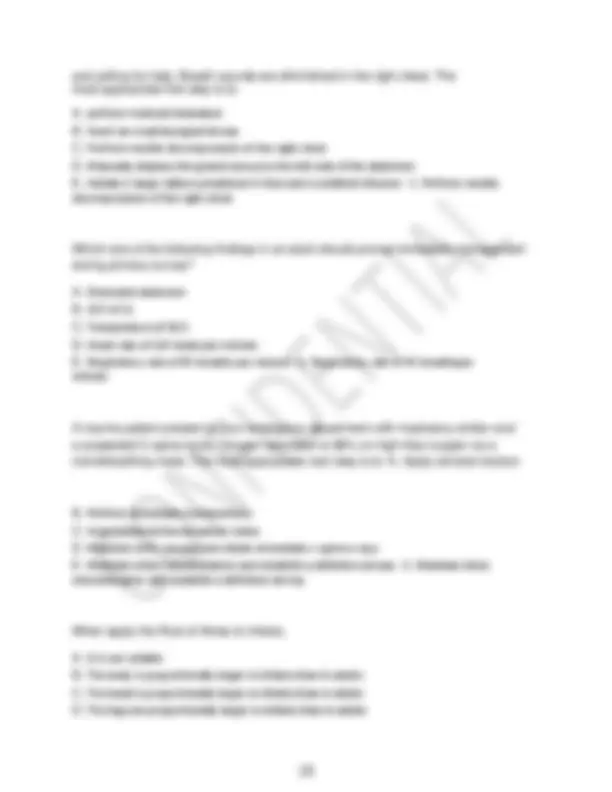
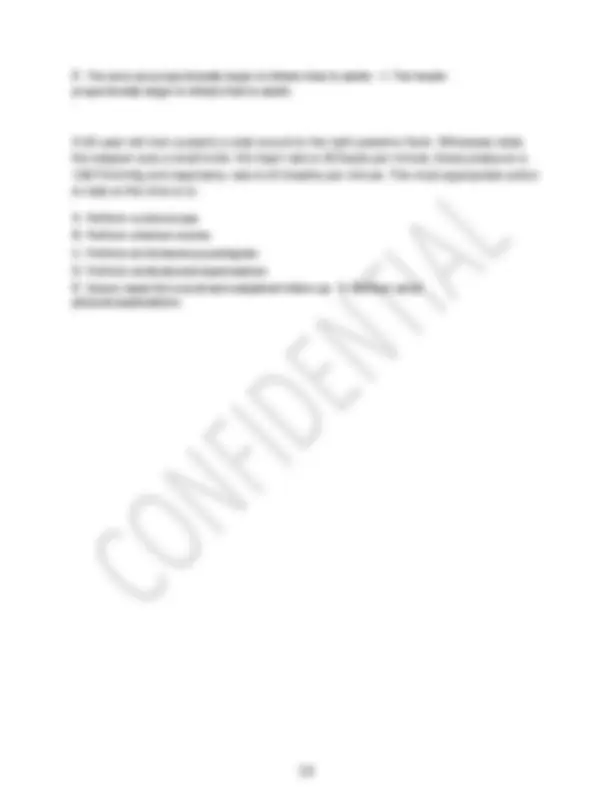
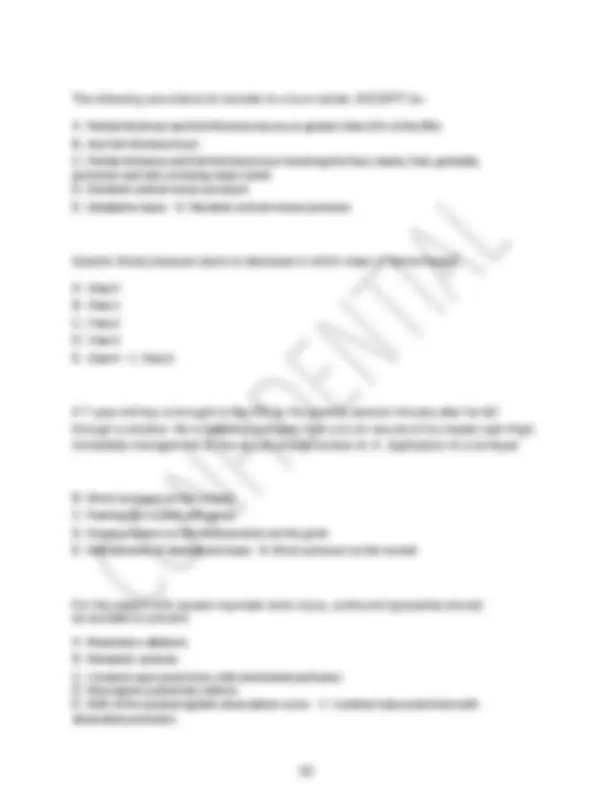

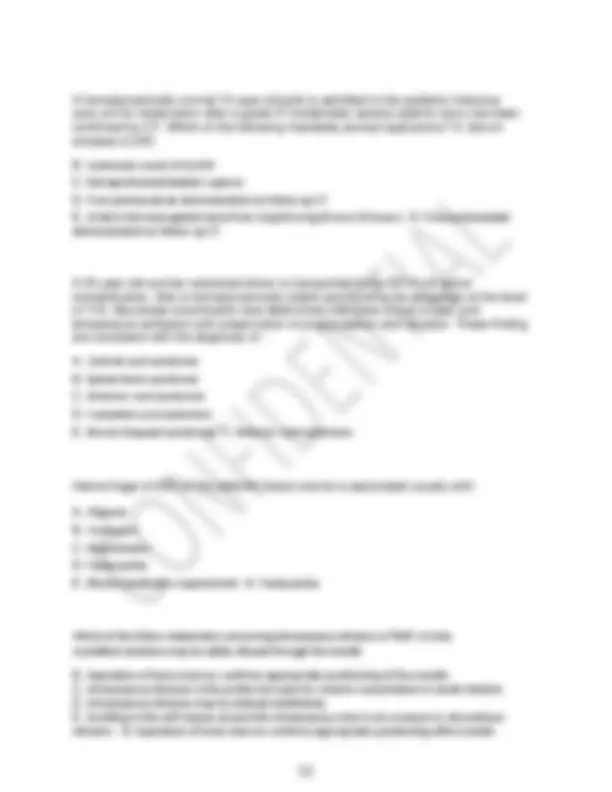

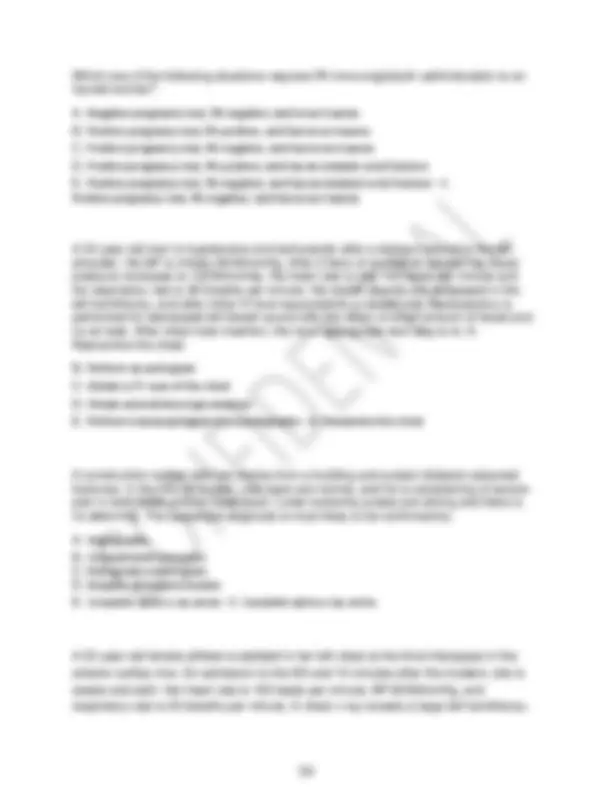
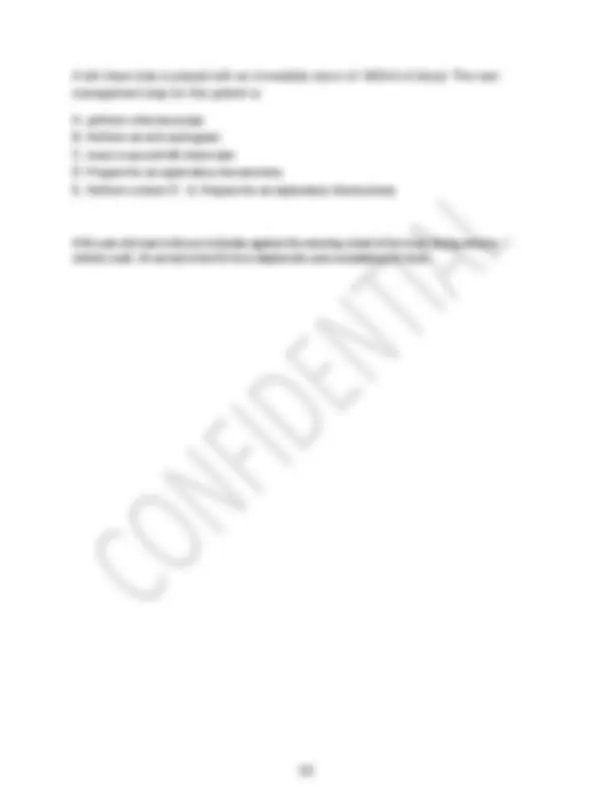
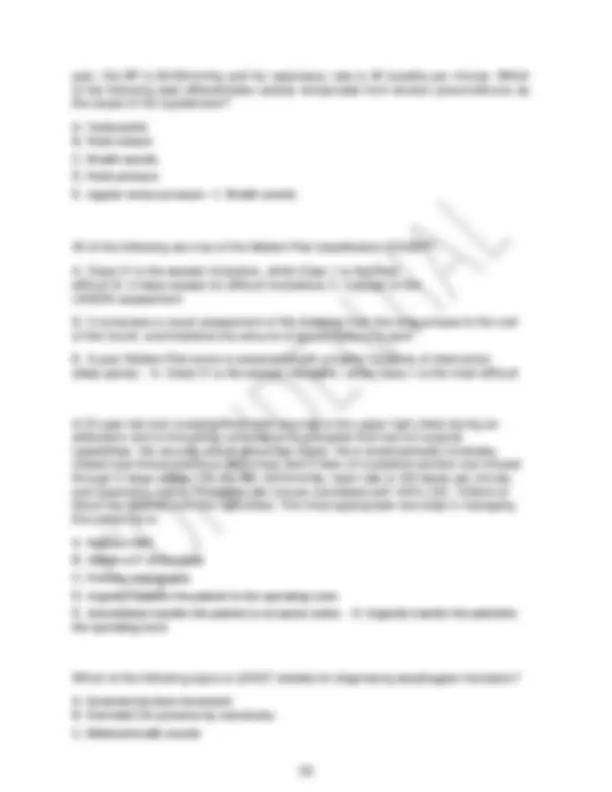

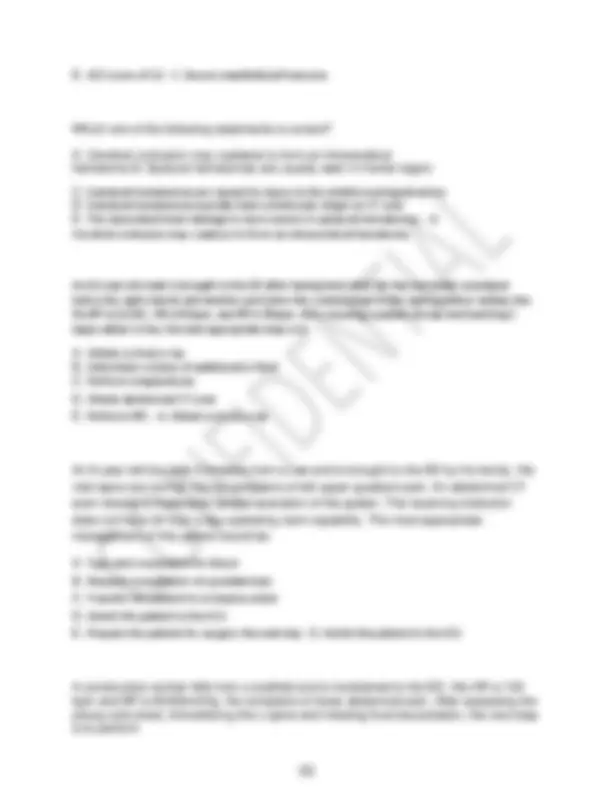

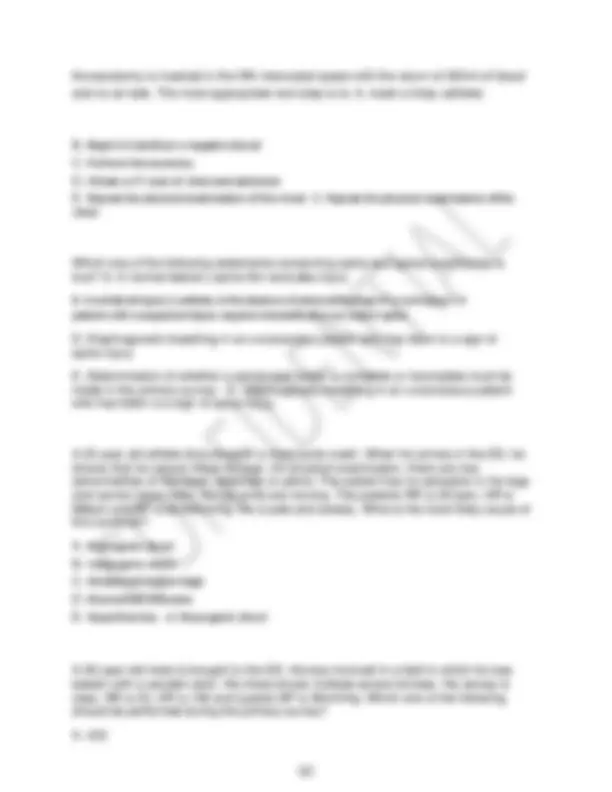


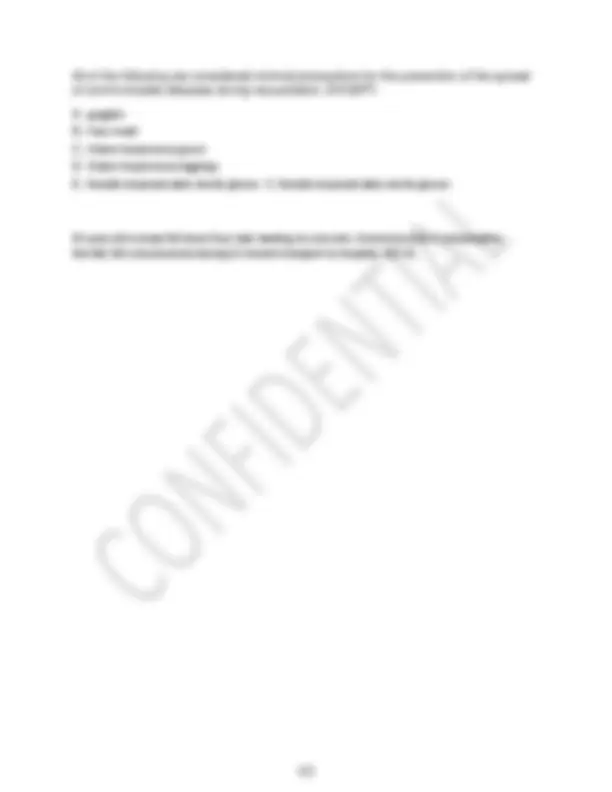
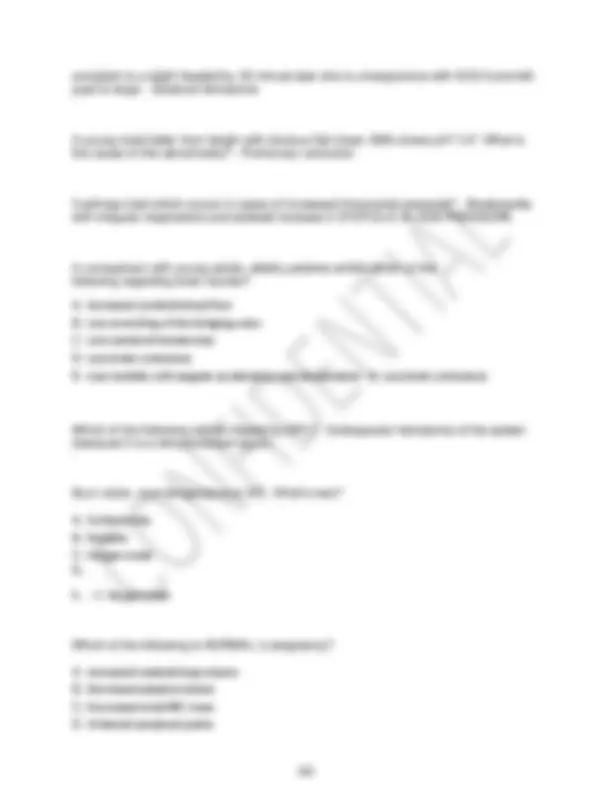
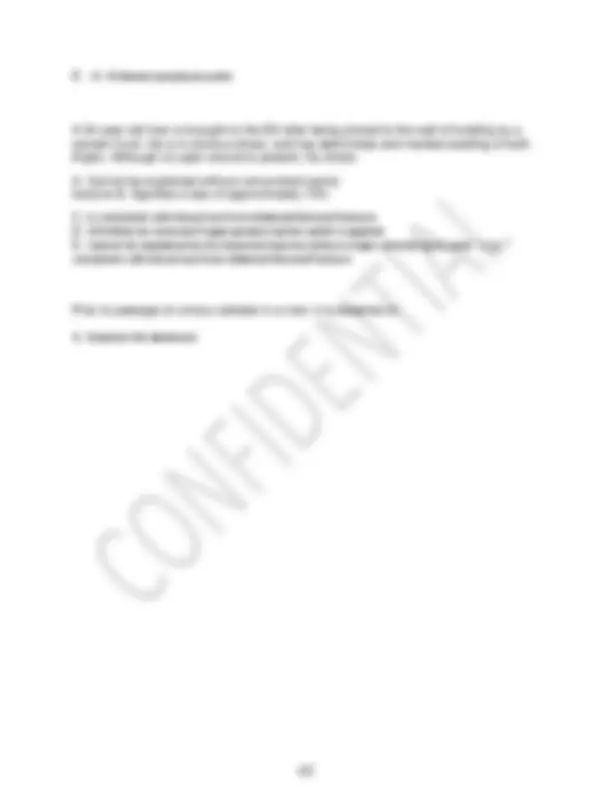
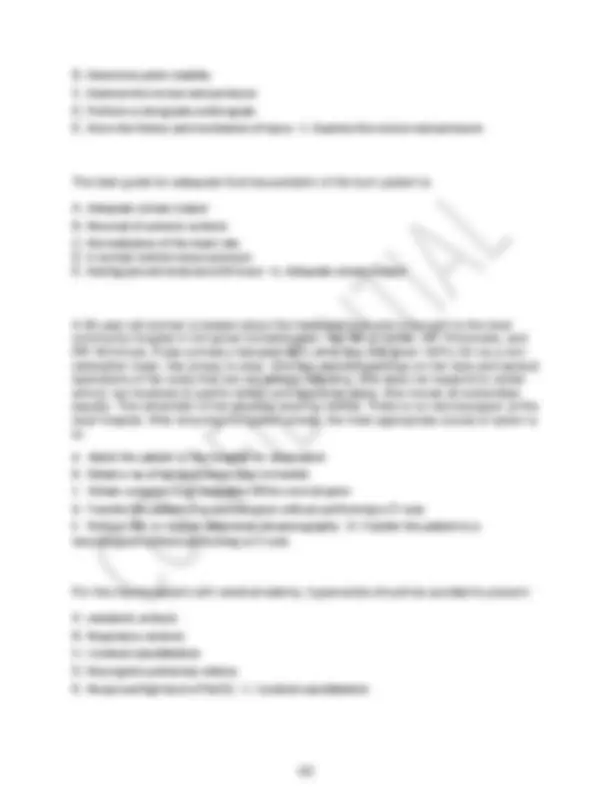

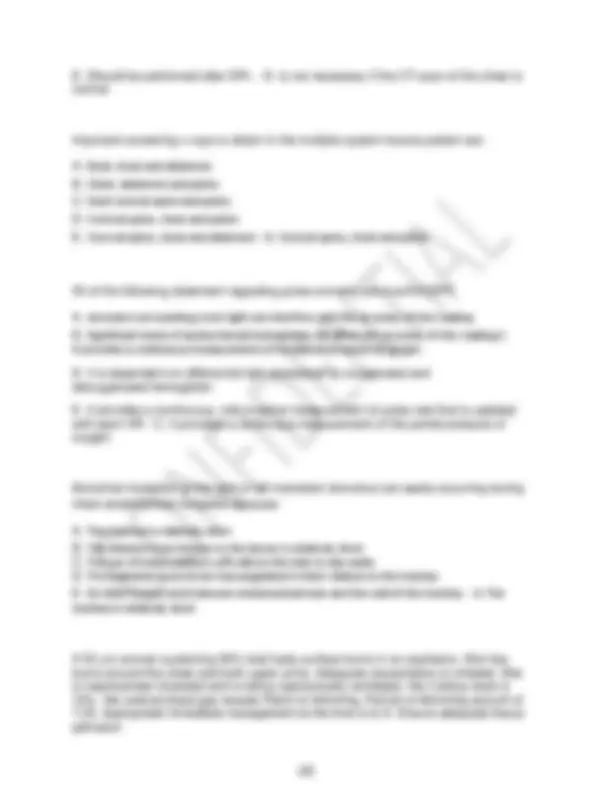

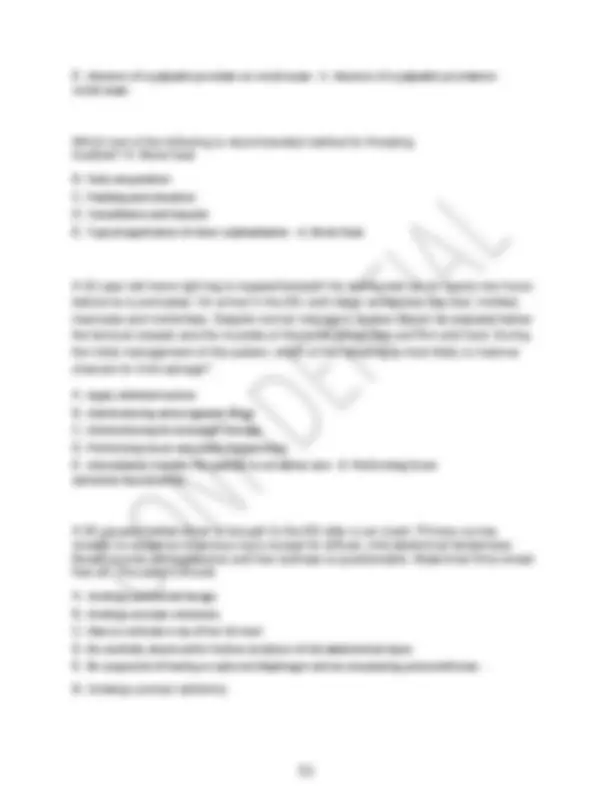

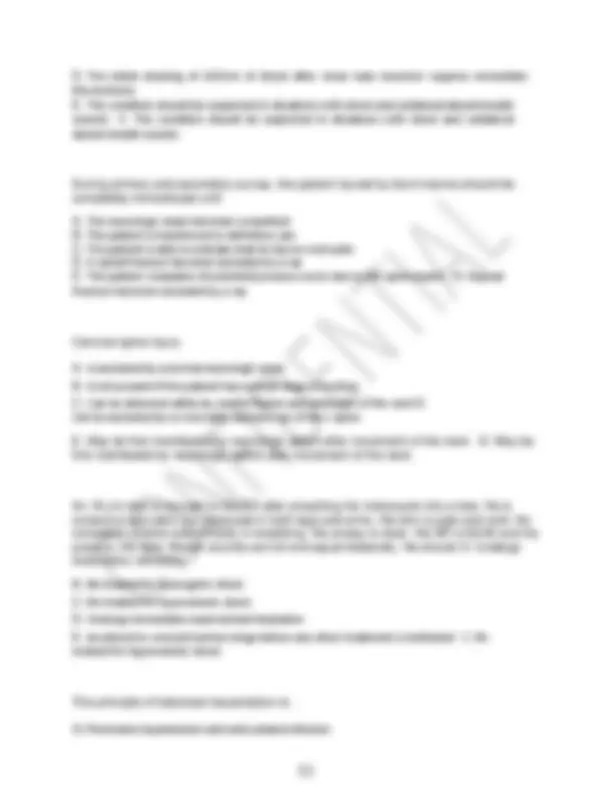
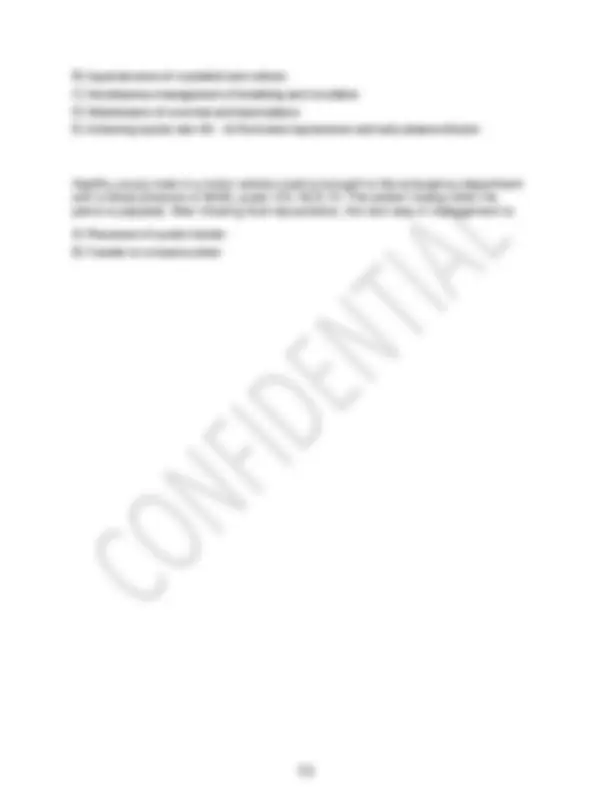
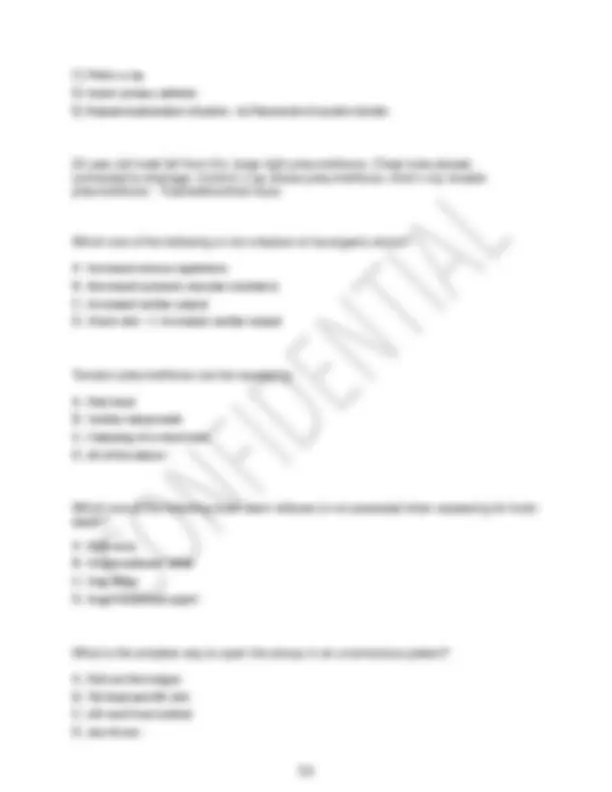

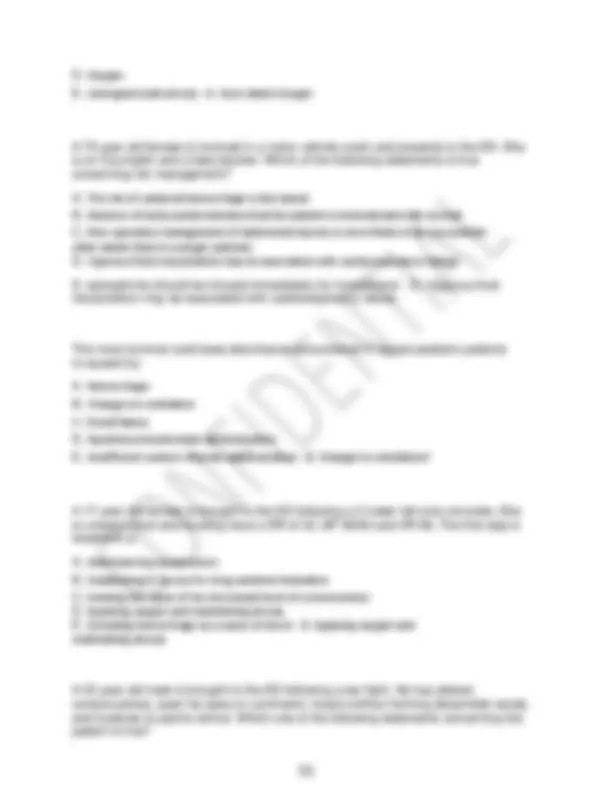
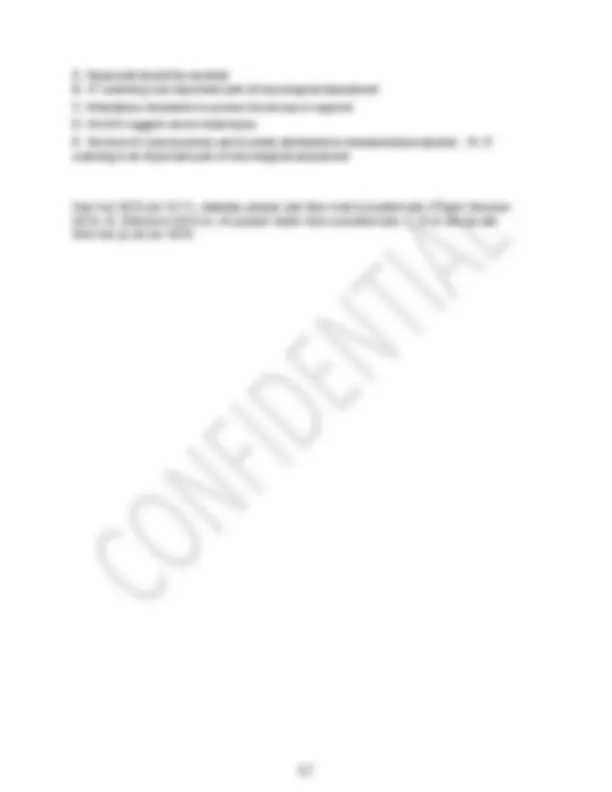
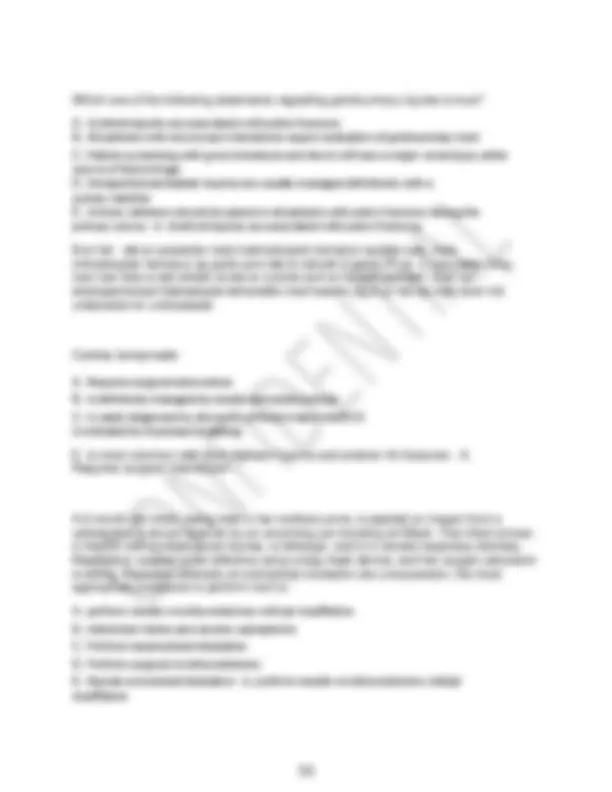
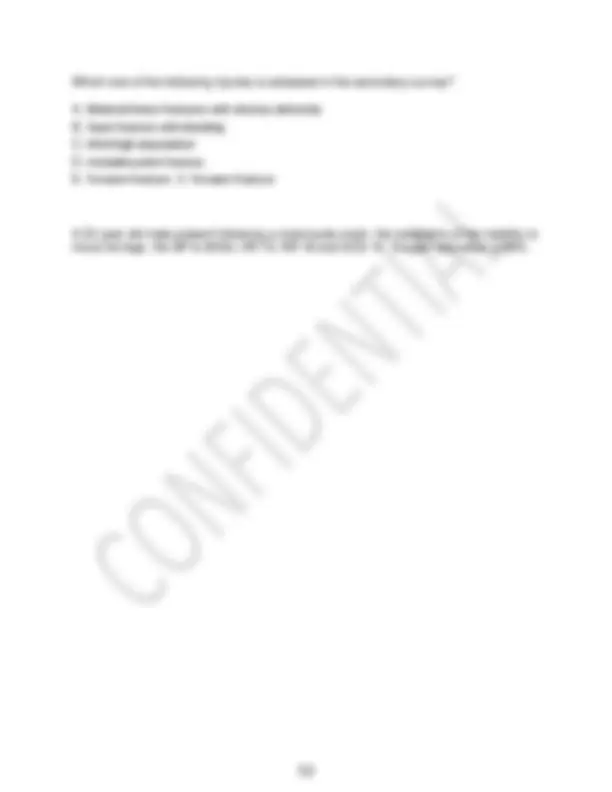
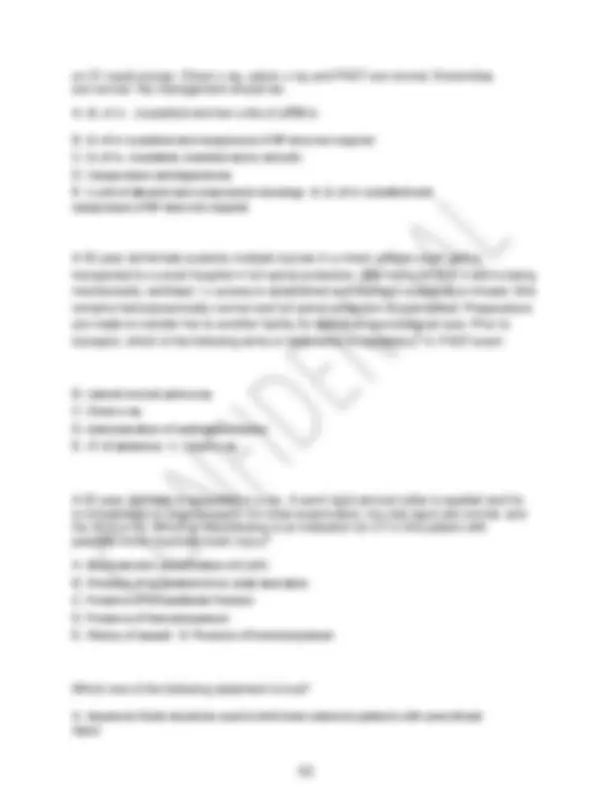
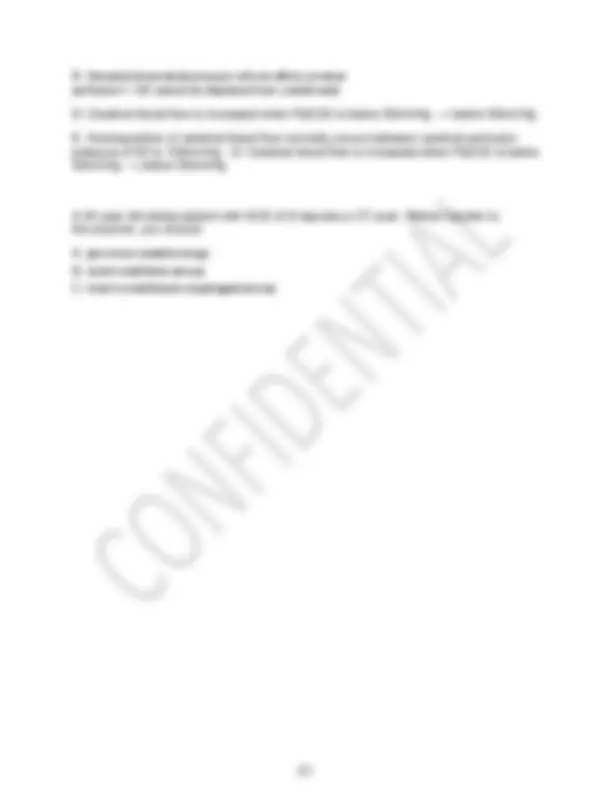
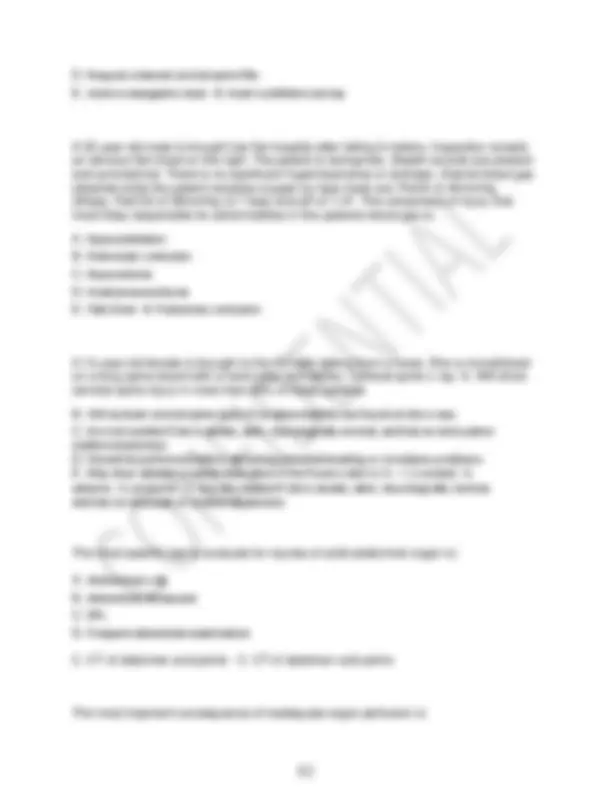

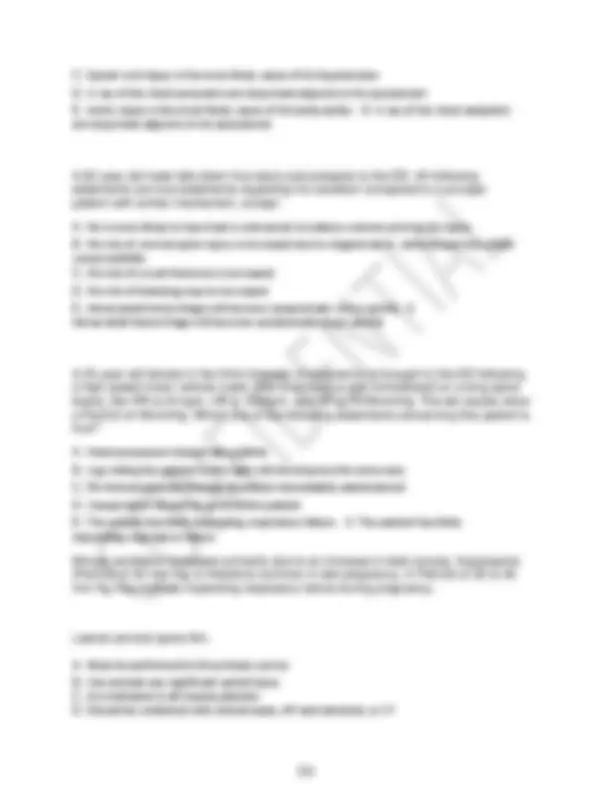
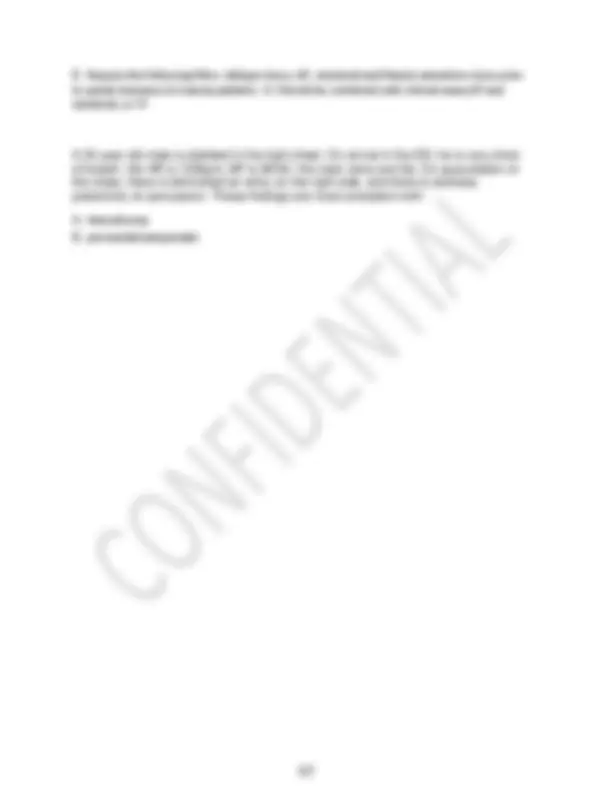
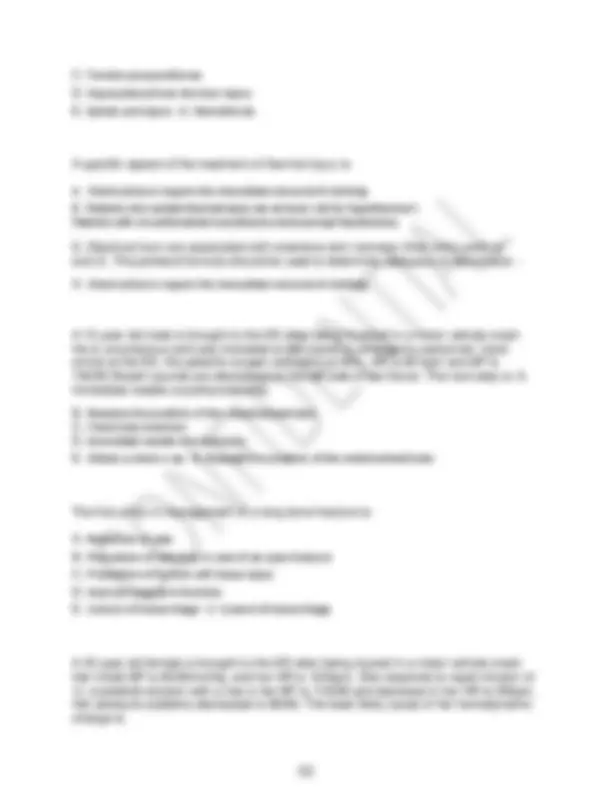

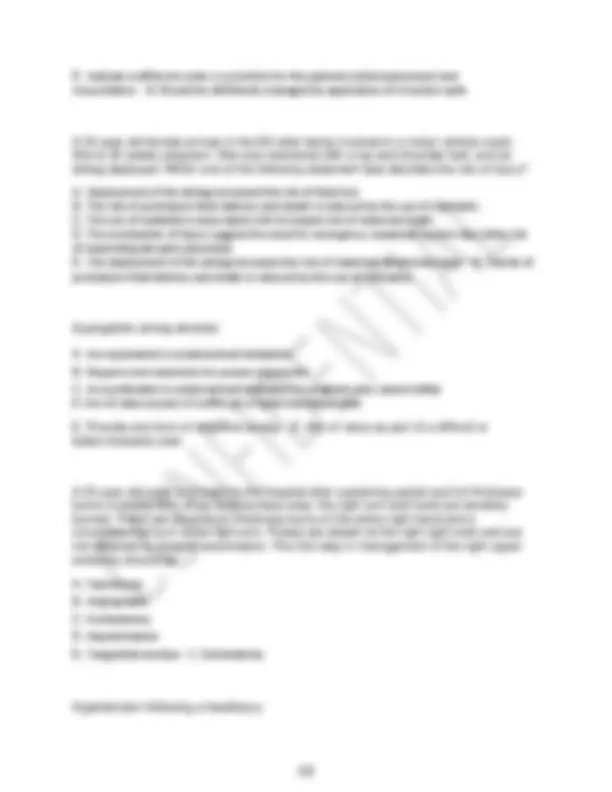
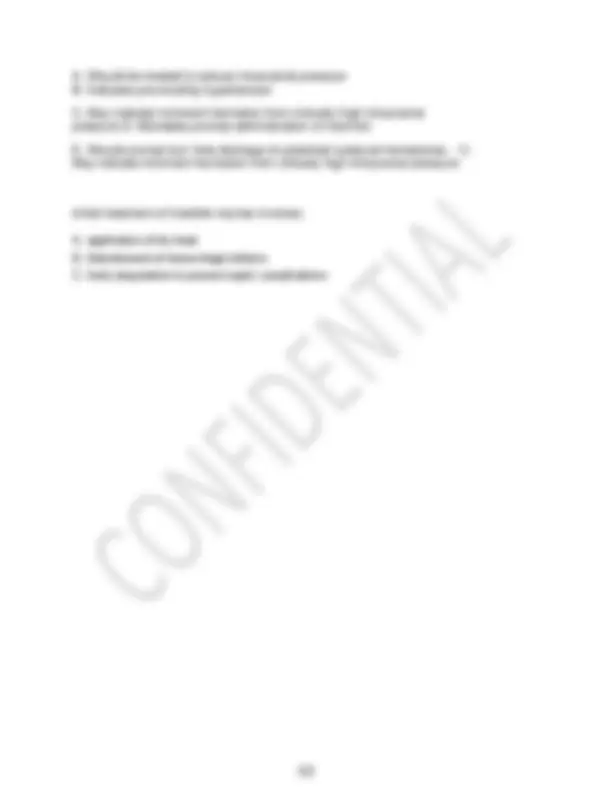
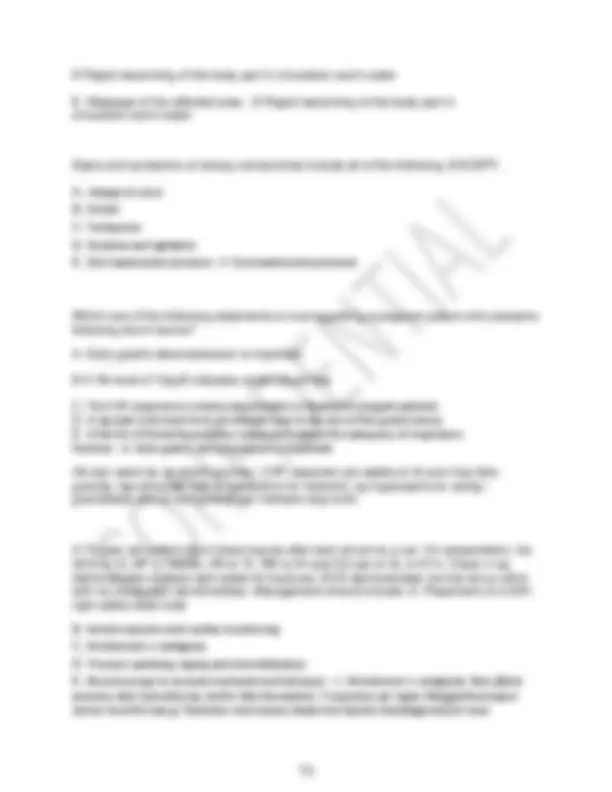

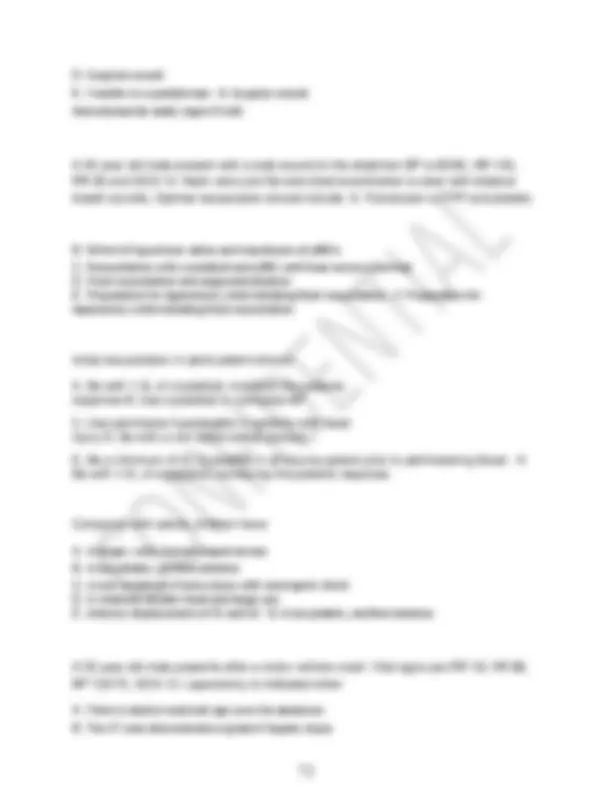
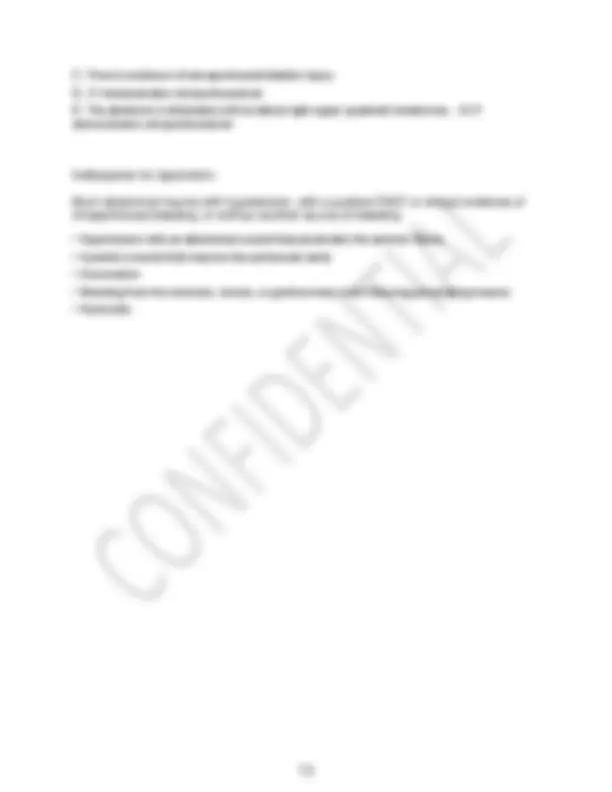
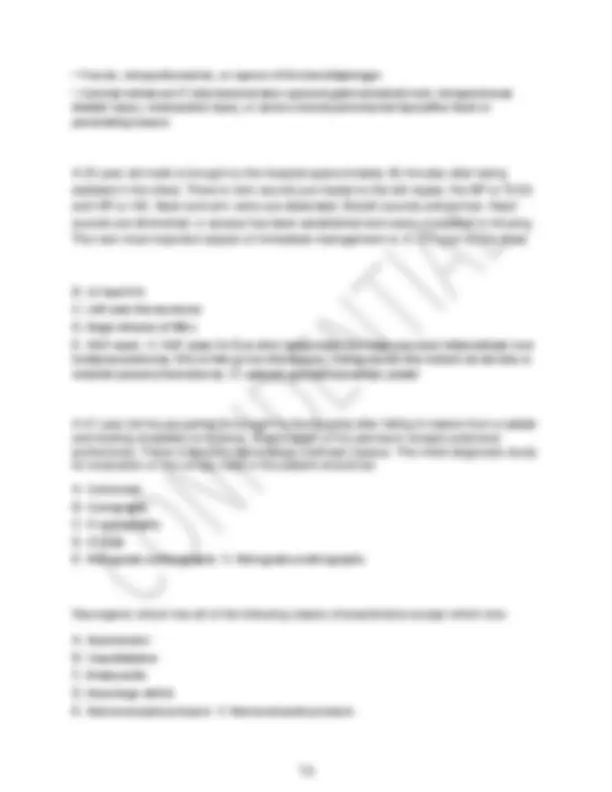



Study with the several resources on Docsity

Earn points by helping other students or get them with a premium plan


Prepare for your exams
Study with the several resources on Docsity

Earn points to download
Earn points by helping other students or get them with a premium plan
Community
Ask the community for help and clear up your study doubts
Discover the best universities in your country according to Docsity users
Free resources
Download our free guides on studying techniques, anxiety management strategies, and thesis advice from Docsity tutors
ATLS10 (2025) Exam Post-Test With Detailed & Verfied Questions andAnswers | 100% Confirmed Solved Solutions | 100% Success | Graded A+
Typology: Exams
1 / 75

This page cannot be seen from the preview
Don't miss anything!




































































Which of the following is the recommended Method for treatment frostbite? A. Vasodilators B. Anticigulants C. Warm (40 degrees) water D. Padding and elevation E. Application of heat from a hairdryer Which of the following physical findings suggest a cause of hypotension other than spinal cord injury? A. Priapism B. Bradycardia C. Diaphragmatic breathing D. Presence of deep tendon reflexes E. Ability to flex forearms but not extend them
pressure is 58mmHg. Warmed crystalloid fluids are initiated without improvement in his vital signs. The next, most appropriate, step is to perform: A. a laparotomy B. An abdominal CT-scan C. Diagnostic laparoscopy D. Abdominal ultrasonography E. A diagnostic peritoneal lavage
C. Central cord syndrome D. Intracerebral hemorrhage E. Bilateral compartment syndrome A 6-year-o boy is struck by an automobile and brought to the ED. He is lethargic, but withdraws purposefully from painful stimuli. His blood pressure is 90mmHg systolic, heart rate 140 beats per minute and his respiratory rate is 36 breaths per minute. The preferred route of venous access in this patient is: A. Percutaneous femoral vein cannulation B. Cutdown on the saphenous vein at the ankle C. Intraosseous catheter placement in the proximal tibia D. Percutaneous peripheral veins in the upper extremities E. Central venous access via the subclavian or internal jugular vein A young man sustains a gunshot wound to the abdomen and is brought promptly to the ED by prehospital personnel. His skin is cool and diaphoretic, and he is confused. His pulse is thready and his femoral pulse is only weakly palpable. The definitive treatment in managing this patient is to: A. Administer O-negative blood B. Apply external warming devices C. Control internal hemorrhage operatively D. Apply a pneumatic antishock garment (PASG) E. Infuse large volumes of intravenous crystalloid solutions. Regarding shock in the child, which of the following is FALSE? A. Vital signs are age-related B. Children have greater physiologic reserves than do adults C. Tachycardia is the primary physiologic response to hypovolemia D. The absolute volume of blood loss required to produce shock is the same as inadults E. An initial fluid bolus for resuscitation should approximate 20ml/kg Ringers Lactate A 33-year-old man is struck by a car travelling at 56km/h (35mph). He has obvious fractures of the left tibia near the knee, pain in the pelvic area, and severe dyspnea. His heart rate is 182 beats per minute, and his respiratory rate is 48 breaths per minute with
no breath sounds heard in the left chest. A tension pneumothorax is relieved by immediate needle decompression and tube thoracostomy. Subsequently, his heart rate decreases to 144 beats per minute, his respiratory rate decreases to 36 breaths per minute and his blood pressure is 81/53 mmHg. Warmed Ringers lactate is administered intravenously. The next priority should be to: A. Perform external fixation of the pelvis B. Obtain abdominal and pelvic CT-scans C. Perform arterial embolization of the pelvic vessel D. Perform diagnostic peritoneal lavage or FAST E. Perform a urethrogram and cystogram
A previously healthy, 70kg (175 pound) man suffers an estimated acute blood loss of two liters. Which one of the following statements apply to this patient? A. His pulse pressure will be widened B. His urinary output will be at the lower limits of normal C. He will have tachycardia, but no change in systolic blood pressure D. His systolic blood pressure will be decreased with a narrowed, pulse pressure E. His systolic blood pressure will be maintained with an elevated diastolic pressure. The physiologic hypervolemia of pregnancy has clinical significance in the management of the severely injured gravid woman by A. Reducing the need for blood transfusion B. Increasing the risk of pulmonary edema
C. Complicating the management of closed head injury D. Increasing the volume of blood loss to produce shock/maternal hypotension E. Reducing the volume of crystalloid required for resuscitation A 17-year-old helmeted motorcyclist loses consciousness when he is struck broad side by an automobile at an intersection. He arrives in the ED with a blood pressure of 140/92, pulse rate 88 beats per minute, a respiratory rate of 18 breaths per minute, and a GCS of 7. Appropriate initial immobilization of this patient should include a semi-rigid cervical collar and: A. A scoop stretcher B. A long spine board C. A short spine board D. Cervical traction tongs E. Pneumatic antishock garment During an altercation, a 36 - year-old man sustains a gunshot wound above the nipple line on the right, with an exit wound posteriorly above the scapula on the right. He is transported by ambulance to a community hospital. He is endotracheally intubated, close tube thoracostomy is performed, and 2 liters Ringers lactate solution are infused via 2 large-caliber IV´s. His blood pressure now is 60/0mmHg, heart rate is 160 beats per minute, and respiratory rate is 14 breaths per minute (ventilated with 100% O2). The most appropriate next step in managing this patient is: A. Laparotomy B. Diagnostic peritoneal lavage C. Arterial blood gas determination D. Administer packed red blood cells E. Chest X-ray to confirm tube placement Absence of breath sounds and dullness to percussion over the left hemithorax are findings best explained by: A. Left hemothorax B. Cardiac contusion C. Left simple pneumothorax D. Left diaphragmatic rupture E. Right tension pneumothorax
A teen-aged bicycle rider is hit by a truck traveling at high speed. In the ED, she is actively bleeding from open fractures of her legs, and has abrasions on her chest and abdominal wall. Her blood pressure is 80/50 mmHg, heart rate is 140 beats per minute, respiratory rate is 8 breaths per minute, and GCS score is 6. The first step in managing this patient is to: A. Obtain a lateral cervical spine x-ray B. Insert av central venous pressure line C. Administer 2 liters of crystalloid solution D. Perform endotracheal intubation and ventilation E. Apply a pneumatic antishock garment (PASG) and inflate the leg compartments. An 8-year-old boy falls 4,5 meters (15 feet) from a tree and is brought to the ED by his family. His vital signs are normal, but he complains of left upper quadrant pain. An abdominal CT-scan reveals a moderately severe laceration of the spleen. The receiving institution does not have 24-hour-a-day operating room capabilities. The most appropriate management of this patient would be to A. Type and crossmatch for blood B. Request consultation of a pediatrician C. Transfer the patient to a trauma center D. Admit the patient to the intensive care unit E. Prepare the patient for surgery the next day Which of the following statements regarding injury to the central nervous system in children is TRUE? A. Children suffer spinal cord injury without x-ray abnormality more commonlythan adults. B. An infant with a traumatic brain injury may become hypotensive from cerebral edema C. Initial therapy for the child with traumatic brain injury includes the administration of methylprednisolone intravenously D. Children have more focal mass lesions as a result for traumatic brain injurywhen compared to adults. E. Young children are less tolerant of expanding intracranial mass lesions than adults A 17-year-old helmeted motorcyclist is struck broadside by an automobile at an intersection. He is unconscious at the scene with a blood pressure of 140/90mmHg, heart rate of 90 beats per minute, and respiratory rate of 22 breaths per minute. His
respirations are sonorous and deep. His GCS score is 6. Immobilization of the entire patient may include the use of all the following EXCEPT: A. Air splints B. Bolstering devices C. A long spine board D. A scoop-style stretcher E. A semi-rigid cervical collar Twenty-seven patients are seriously injured in an aircraft accident at a local airport. The basic principle of triage should be to:
A 32 - year-old is brought to the hospital unconscious with severe facial injuries and noisy respirations after an automobile collision. In the ED, he has no apparent injury to the anterior aspect of his neck. He suddenly becomes apneic, and attempted ventilation with a face mask is unsuccessful. Examination of his mouth reveals a large hematoma of the pharynx with loss of normal anatomic landmarks. Initial management of his airways should consist of: A. Inserting an oropharyngeal airway B. Inserting a nasopharyngeal airway C. Performing a surgical cricothyroidotomy D. Performing fiberoptic-guided nasotracheal intubation
E. Performing orotracheal intubation after obtaining a lateral c-spine x-ray A 25-year-old woman is brought to the ED after a motor vehicle crash. She was initially lucid at the scene and then developed a dilated pupil and contralateral extremity weakness. In the ED, she is unconscious and has a GCS score of 6. The initial management step for this patient should be to: A. Obtain a CT-scan of the head B. Administer Decadron 20mg IV C. Perform endotracheal intubation D. Administer mannitol 1g/kg IV E. Perform an emergency bone flap craniotomy on the side of the dilated pupil. - C. Perform endotracheal intubation A contraindication to nasogastric intubation is the presence of a: A. Gastric perforation B. Diaphragmatic rupture C. Open depressed skull fracture D. Fracture of the cervical spine E. Fracture of the cribriform plate - E. Fracture of the cribriform plate An 8-year-old girl is an unrestrained passenger in a vehicle struck from behind. In the ED, her blood pressure is 80/60mmHg, heart rate is 80 beats per minute, and respiratory rate is 16 breaths per minute. Her GCS score is 14. She complains that her legs feel "funny and wont move right". However, her spine x-rays do not show a fracture or dislocation. A spinal cord injury in this child: A. Is most likely a central cord syndrome B. Must be diagnosed by magnetic resonance imaging C. Can be excluded by obtaining a CT-scan of the entire spine D.May exist in the absence of objective findings on x-ray studies E. Is unlikely because of the incomplete calcification of the vertebral bodies. - D. May exist in the absence of objective findings on x-ray studies Immediate chest tube insertion is indicated for which of the following conditions?
A 22-year-old man is brought to the hospital after crashing his motorcycle into a telephone pole. He is unconscious and in profound shock. He has no open wounds or obvious fractures. The cause of his shock is MOST LIKELY caused by: A. A subdural hematoma B. An epidural hematoma C. A transected lumbar spinal cord D. A basilar skull fracture E. Hemorrhage into the chest or abdomen - E. Hemorrhage into the chest or abdomen Which of the following statements is FALSE concerning Rh-isoimmunization in the pregnant trauma patient? A. It occurs in blunt or penetrating abdominal trauma B. Minor degrees of fetomaternal hemorrhage produce it C. A negative Keilhauer-Betke test excludes Rh-Isoimmunization D. This is not a problem in the traumatized Rh-positive pregnant patient E. Initiation of Rh-immunoglobulin therapy does not require proof of fetomaternal hemorrhage - C. A negative Keilhauer-Betke test excludes Rh-Isoimmunization All of the following signs on the chest x-ray of a blunt injury victim may suggest aortic rupture EXCEPT: A. Mediastinal emphysema B. Presence of a "pleural cap" C. Obliteration of the aortic knob D. Deviation of the trachea to the right E. Depression of the left mainstem bronchus - A. Mediastinal emphysema Early central venous pressure monitoring during fluid resuscitation in the ED has the greatest utility in a: A. Patient with a splenic laceration B. Patient with an inhalation injury C. 6 - year-old child with a pelvic fracture D. Patient with a severe cardiac contusion E. 24 - year-old man with a massive hemothorax - D. Patient with a severe cardiac contusion
A cross-table lateral x-ray of the cervical spine: A. must precede endotracheal intubation B. excludes serious cervical spine injury C. Is an essential part of the primary survey D. Is not necessary for unconscious patients with penetrating cervical injuries E. Is unacceptable unless 7 cervical vertebrae and the C-7 to T-1 relationship are visualized. - E. Is unacceptable unless 7 cervical vertebrae and the C-7 to T- 1 relationship are visualized.
D. Management of blood loss E. Determination of associated injuries - B. Upper airway protection The driver of a single car crash is orotracheally intubated in the field by prehospital personnel after they identify a closed head injury and determine that the patient is unable to protect his airway. In the ED, the patient demonstrates decorticate posturing bilaterally. He is being ventilated with a bag-valve device, but his breath sounds are absent in the left hemithorax. His blood pressure is 160/80mmHg, heart rate is 70 beats per minute, and the pulse oximeter displays a hemoglobin oxygen saturation of 96%. The next step in assessing and managing this patient should be to:
A. Determine the arterial blood gases B. Obtain a lateral cervical spine x-ray C. Assess placement of the endotracheal tube D. Perform needle decompression of the left chest E. Insert a thoracostomy in the left hemithorax. - C. Assess placement of the endotracheal tube The response to catecholamines in an injured, hypovolemic pregnant woman can be expected to result in: A. Placental abruption B. Fetal hypoxia and distress C. Fetal/maternal dysrhythmia D. Improved uterine blood flow E. Increased maternal renal blood flow - B. Fetal hypoxia and distress A 22-year-old man sustains a gunshot wound to the left chest and is transported to a small community hospital at which surgical capabilities are not available. In the ED, a chest tube is inserted and 700ml of blood is evacuated. The trauma center accepts the patient in transfer. Just before the patient is placed in an ambulance for transfer, his blood pressure decreases to 80/68mmHg and his heart rate increases to 136 beats per minute. The next step should be to: A. Clamp the chest tube B. Cancel the patients transfer C. Perform an ED thoracotomy D. Repeat the primary survey and proceed with transfer E. Delay the transfer until the referring doctor can contact a thoracic surgeon. - D. Repeat the primary survey and proceed with transfer A young woman sustains a severe head injury as the result of a motor vehicular crash. In the ED, her GCS is 6. Her blood pressure is 140/90 mmHg and her heart rate 80 beats per minute. She is intubated and is being mechanically ventilated. Her pupils are 3 mm in size and equally reactive to light. There is no other apparent injury. The most important principle to follow in early management of her head injury is to: A. Avoid hypotension B. Prevent secondary brain injury C. Aggressively treat systemic hypertension D. Reduce metabolic requirements of the brain